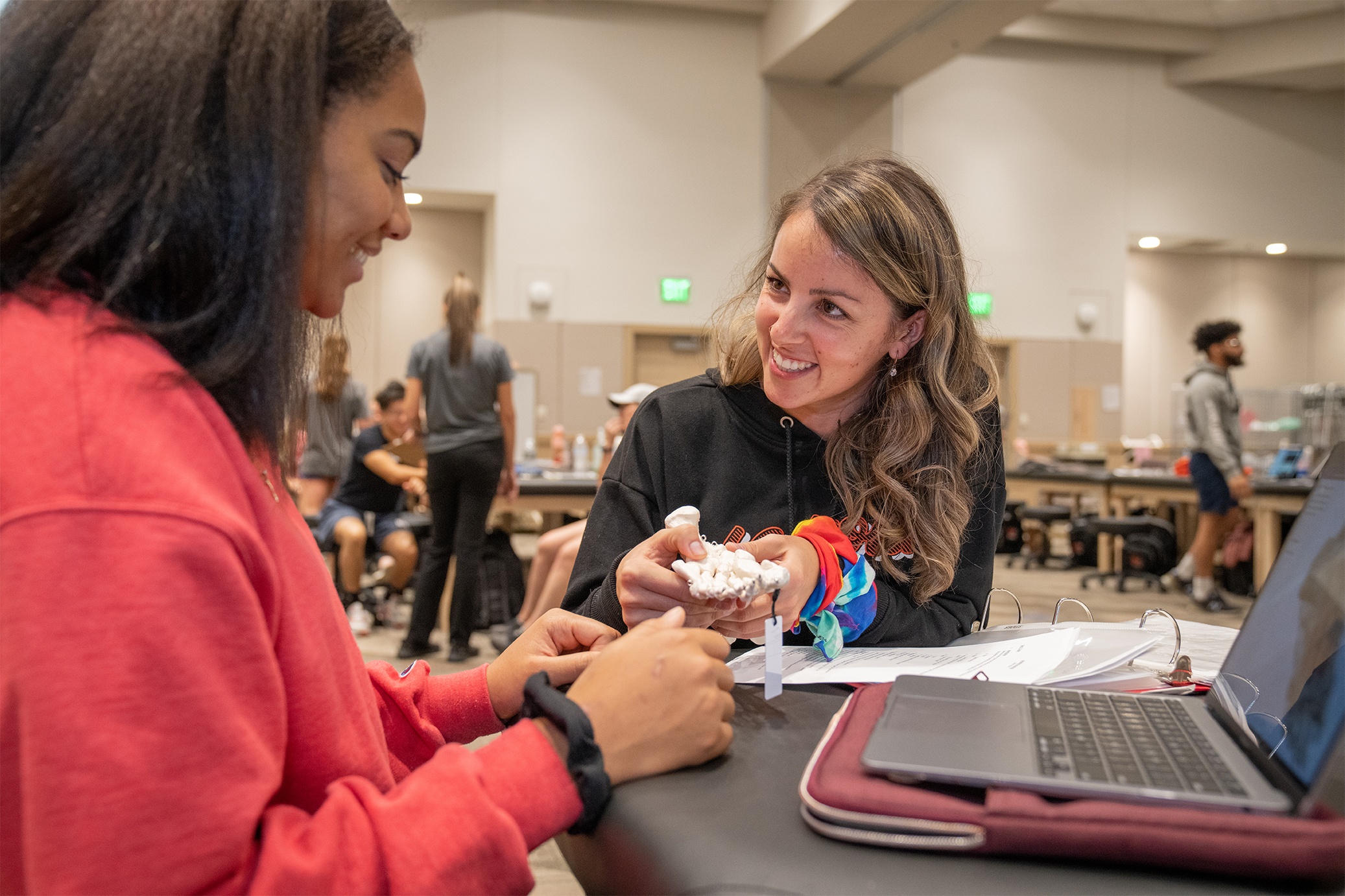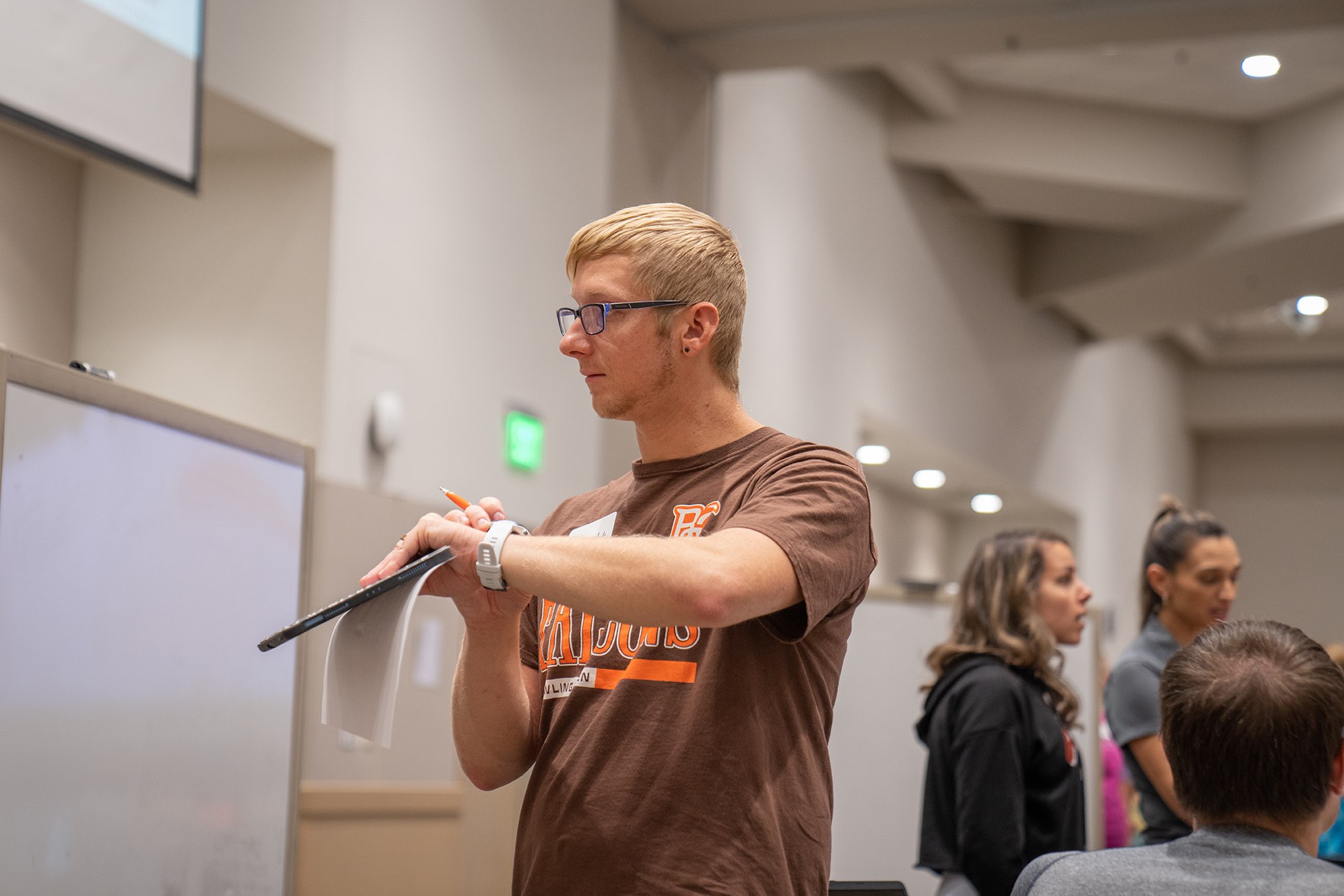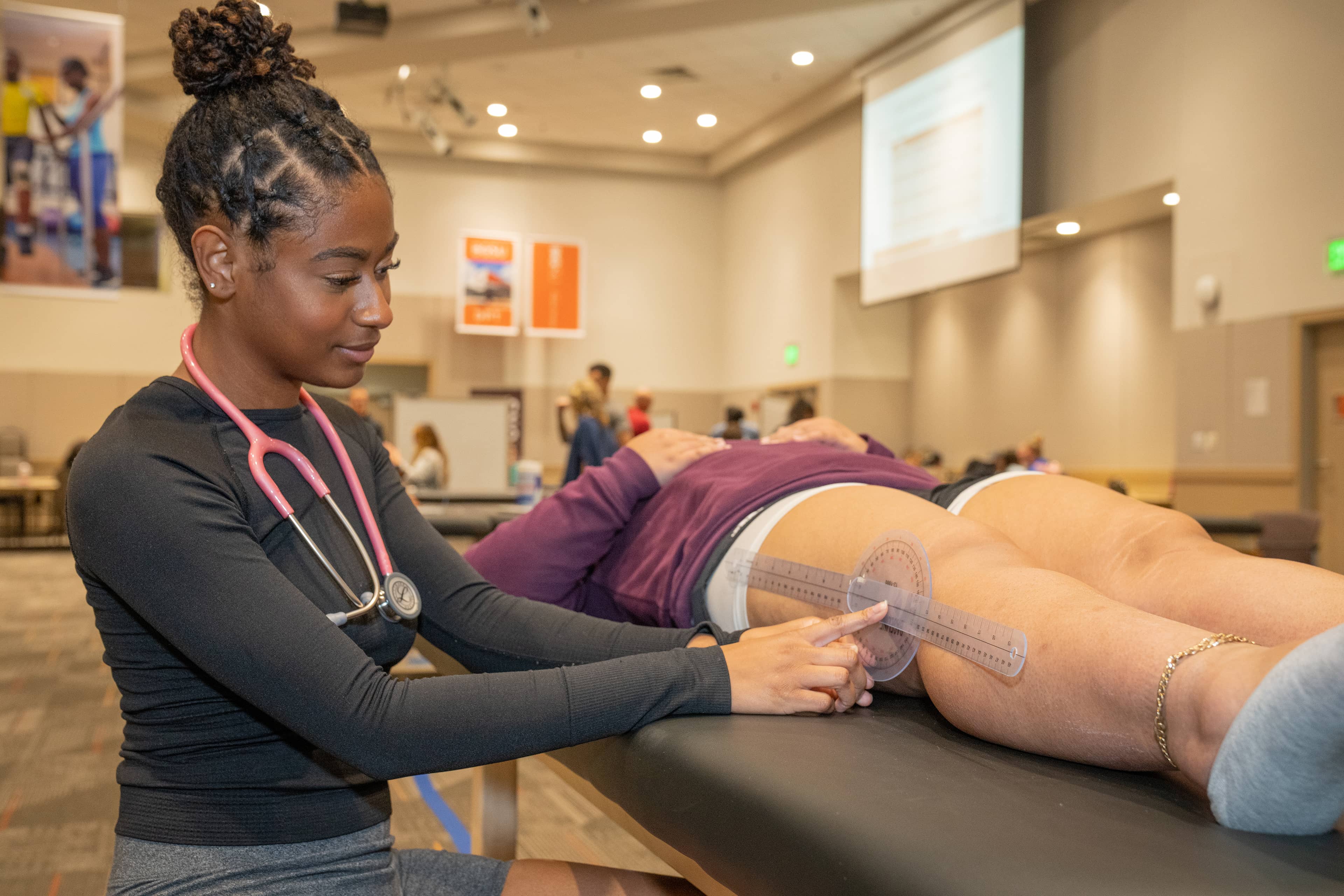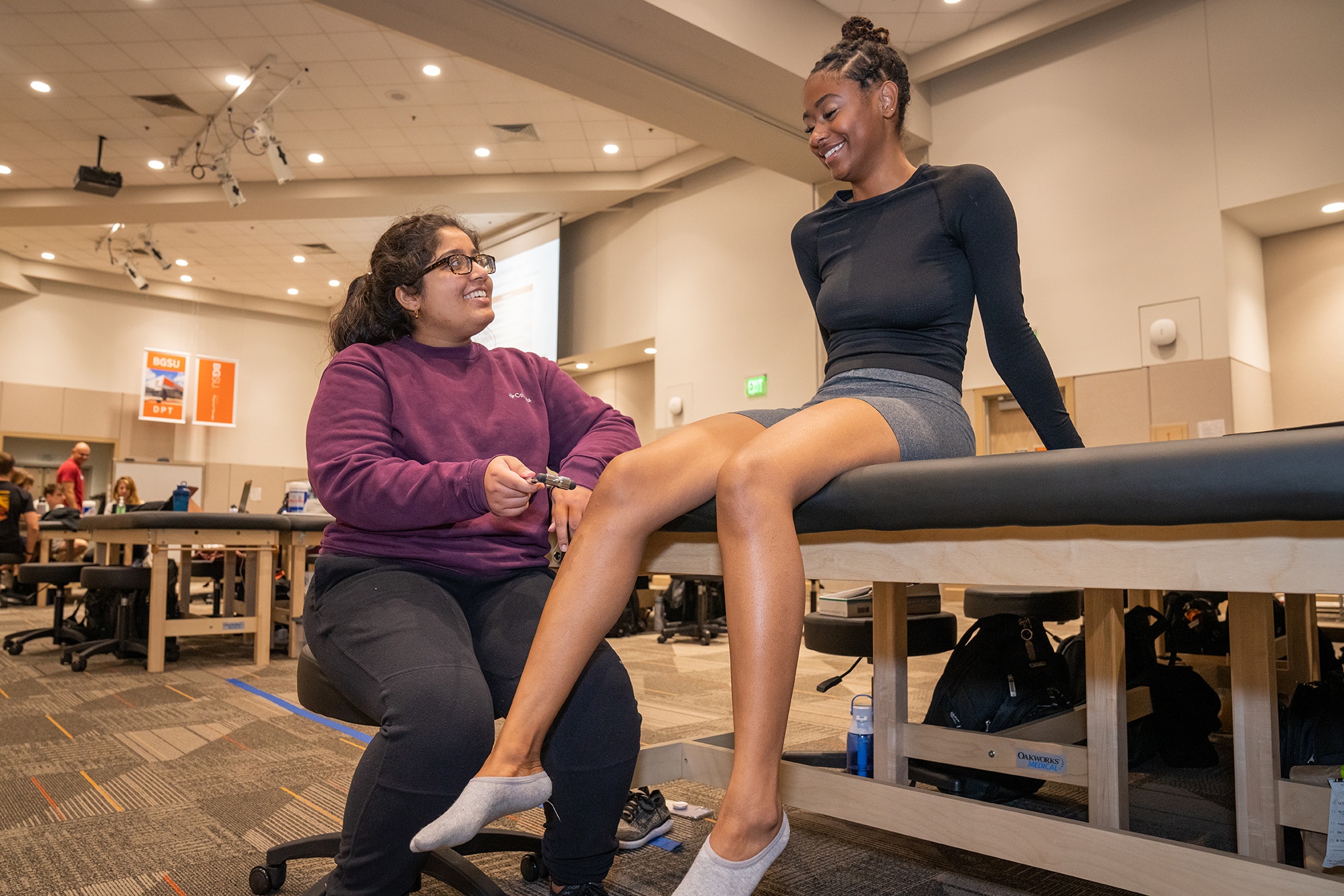
1st cohort of innovative BGSU Doctor of Physical Therapy program reflects program's core tenets of diversity, inclusion
Students from across the country say they were drawn to the new program for its mission and hybrid flexibility
By Laren Kowalczyk '07
As a working mom of two young children, Tedi Bunch was initially drawn to the new Doctor of Physical Therapy (DPT) program at Bowling Green State University for its hybrid flexibility and accelerated format.
But as she sat in orientation in Olscamp Hall in August and listened to the program’s commitment to diversity and inclusion, she realized its mission is much more profound.
“During our orientation, the faculty discussed how they’re building a nurturing and inclusive environment. Not only did they talk about diversity and inclusion, but I could see it right there all around me,” Bunch said. “Getting to know my cohort team that first orientation week, I was amazed and energized by our diversity and passion for physical therapy.”
Bunch, a U.S. Army veteran, is one of 96 students in the first cohort of the DPT program at BGSU that began this fall. The program is Ohio’s first and only public, accelerated, hybrid DPT program and is the largest cohort in the state.
More than three-fourths of the class, including Bunch, live outside Ohio and represent 27 states across America. The widespread cohort is made possible through the program’s hybrid approach that allows students to complete most of their coursework online. Students come to campus twice per semester for hands-on clinical practice.
Increasing diversity in the profession
The program, housed in the new School of Physical Therapy, has a dedicated director of diversity and belonging, a unique role at the program level that signifies its commitment to building a diverse and inclusive community of students, educators and staff.
In that role, Dr. Melissa Yeung is focused on enhancing the representation of minoritized groups within physical therapy with the belief that a diverse community is stronger and more impactful in driving public good.
“Our goal is to build a program that gives future physical therapists the tools to not only work with patients from diverse identities and backgrounds, but to help them develop an understanding of healthcare inequities,” she said. “We want our students to feel empowered as physical therapists to create positive change within the communities that they serve.”
The first cohort includes students from various racial, ethnic and economic backgrounds, including non-traditional students, military and veteran students and students from medically underserved areas. Minoritized students account for 37% of the class.
“Our charter cohort makes up one of the most diverse cohorts within physical therapy education in the U.S. and is a reflection of an intentional recruitment and admissions process that prioritizes the backgrounds and identities of students and their potential to be physical therapists,” Yeung said. “We hope that the work we are doing here at BGSU is a small step toward the diversification of the profession.”
Building a support network
Aside from the program’s emphasis on diversity and inclusion, Bunch said efforts to provide a strong support network have been helpful. Students were grouped into teams of 10 during orientation, led by an academic coach.
The goal is to ensure students feel supported in their journey, said Dr. Tricia Prokop, director of student affairs for the DPT program.
“Our coaching program is intentionally designed to not only create supportive connections and sense of community within the larger cohort, but also to support and develop the strengths of each individual student,” she said. “This strengths-based approach facilitates student success in the program and their careers and is especially effective in supporting a diverse student body such as ours because it acknowledges the unique aspects of each student.”
For Bunch, who lives in Fayetteville, North Carolina, the bonds formed at orientation have been integral, even just a few months into the program.
“Even though we’re all spread out across the United States, I know I have someone who is going through the same thing as me,” she said. “I have these nine people I can reach out to when I’m not sure what to do on an assignment. We exchanged phone numbers and birthdays, and we know each other's families now. We are far apart, but it still feels very personal.”
Garrett Spicer, a local student in Whitehouse, Ohio, said he feels similarly about the team approach. Spicer said he’s only experienced small class sizes in college and has already had several virtual meetings with his academic coach.
“She’s very responsive, and it provides that close-knit student-teacher interaction that I prefer,” Spicer said.

Passions within physical therapy
For the last eight years, Spicer has worked as a physical therapist assistant at a clinic in Sylvania, Ohio. His boss encouraged him to pursue a doctorate in physical therapy and has been among his biggest supporters.
There are plans for Spicer to potentially take over the practice when his boss retires in a few years, the prospect of which is exciting, he said.
“As a physical therapist assistant, I can’t do the initial evaluations of diagnosing and evaluating the patient or developing their plan of care,” Spicer said. “I’m looking forward to more autonomy and the responsibility of deciding how to best help my patients.”
Spicer said he’d also like to incorporate more vestibular rehabilitation - treatment for vertigo - into the clinic. He was exposed to it early in his career and found it fascinating.
“It’s like a big puzzle,” Spicer said. “You have to figure out what’s causing the dizziness and then determine the best way to treat it. I’ve taken some continuing education courses on vestibular rehab, and it’s very intriguing to me.”

Houston native Mekayla Abrahams plans to focus on women’s health, specifically physical therapy before and after childbirth. Although a common practice abroad, Abrahams said it’s a traditionally underserved area in the U.S.
“Physical therapy is not a part of prenatal care, so a lot of women aren’t educated about it,” she said. “That’s something I want to change. Just like a lactation consultant comes in to see a woman after birth, a physical therapist should be included in that care team.”
Part of that interest, Abrahams said, is driven by her personal experiences with bladder health issues. Although initially prescribed medication, Abrahams learned through her interest in physical therapy that core and pelvic floor strengthening exercises could be much more effective.
“In my situation, medicine was being used as a Band-Aid,” she said. “I want to educate women on more holistic options that physical therapy provides.”

Hope and inspiration
Meena Dhawan saw firsthand the impact physical therapy had on her late father, Prem, who suffered a stroke in 2016.
“I remember seeing him grow through physical therapy,” she said. “Seeing him be bedridden to then watching him hop in the front seat of his old car became my motivation. I want to be that person for someone else’s family.”
Dhawan’s involvement in her father’s rehabilitation inspired her to pursue physical therapy as a career. She graduated from Mississippi College with a bachelor’s degree in kinesiology and pre-physical therapy and initially enrolled in a graduate physical therapy program in Iowa.
Dhawan said the program wasn’t a fit, and she preferred being closer to home in Vicksburg, Mississippi. That became a more significant focus after her father died earlier this year.
“With this program, I’ll be able to be in the house, so my mother doesn’t feel so alone,” Dhawan said.
Aside from the hybrid format, Dhawan said the University’s mantra of creating public good stuck with her as a first-generation Indian-American.
“Regardless of economic status, gender or ethnicity, BGSU is for everyone, and that makes me feel like I'm in great hands,” she said.
Related Stories
Media Contact | Michael Bratton | mbratto@bgsu.edu | 419-372-6349
Updated: 11/14/2024 12:11PM




